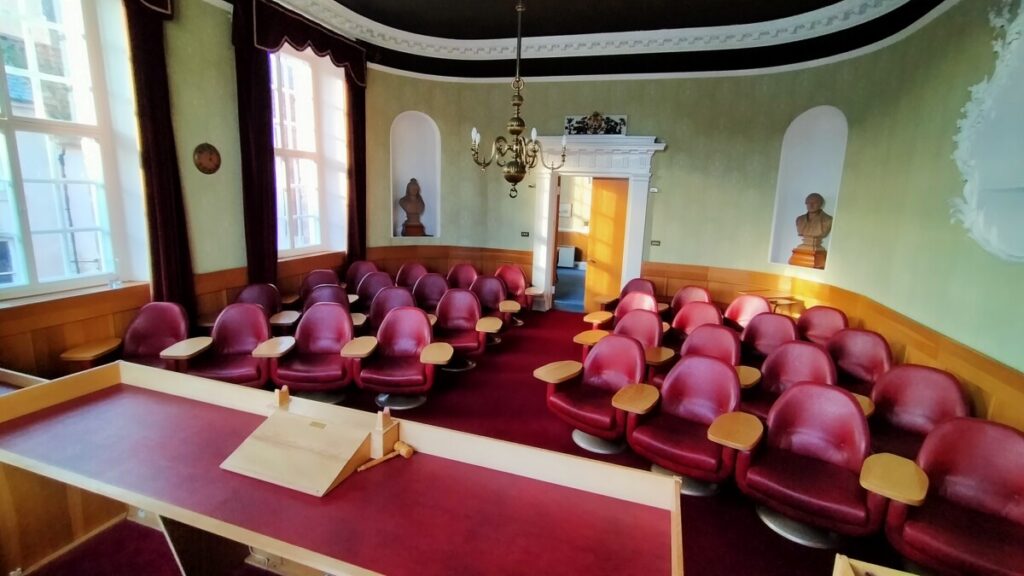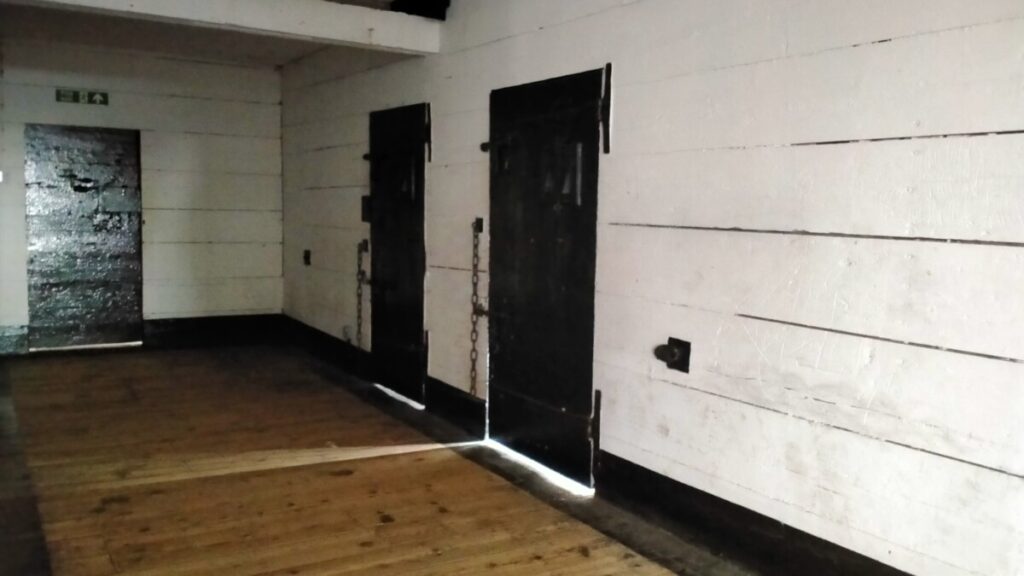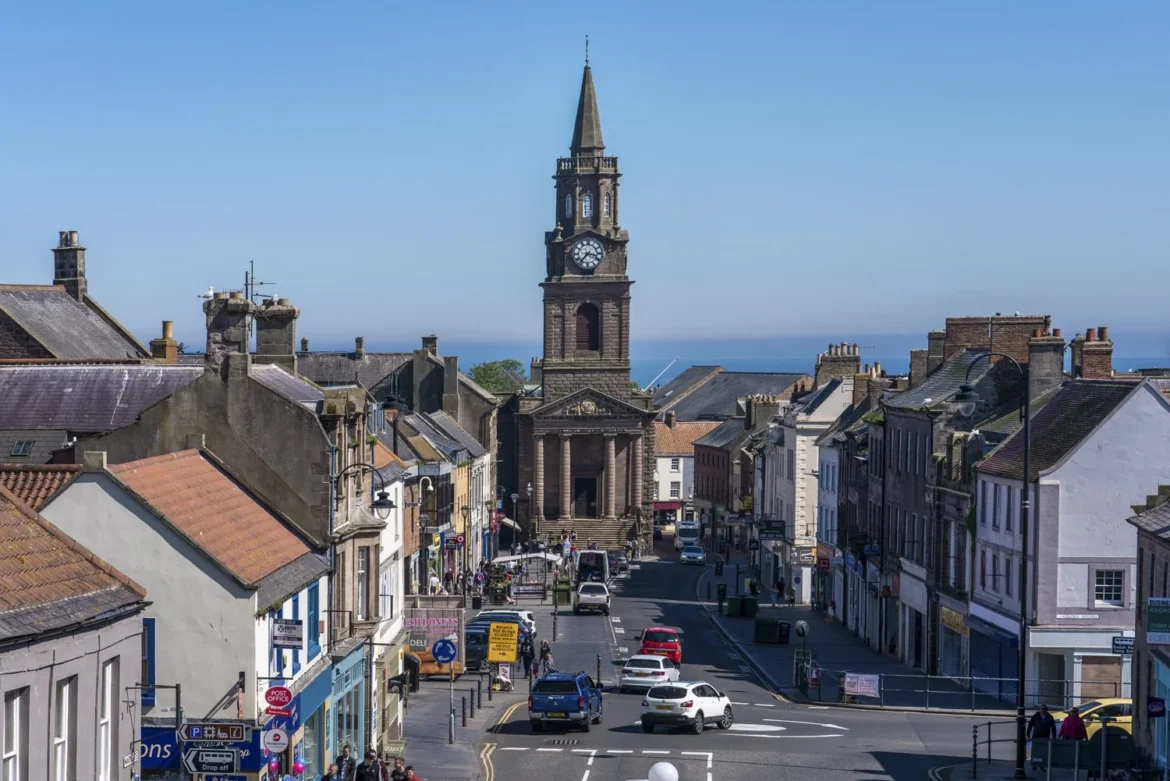Berwick-upon-Tweed, perched on the northernmost edge of England near the Scottish border, has always been a place of significance. Its location has made it a fortress town, a trading hub, and a flashpoint in centuries of conflict between England and Scotland. Amidst its rich history, the Town Hall and Town Gaol stand out as two of the most iconic and fascinating buildings, offering a window into Berwick’s civic and judicial past.
A Landmark at the Heart of the Town
The Town Hall, located in the very centre of Berwick-upon-Tweed, dominates the marketplace with its elegant Georgian architecture. Completed in 1754, it was built to replace an earlier medieval town hall that had fallen into disrepair. The new building was designed not just as a meeting place for the town’s leaders, but also as a visual statement of Berwick’s prosperity and stability.
Constructed in ashlar stone and topped with a distinctive spire, the Town Hall is a symbol of civic pride. Its design reflects the neoclassical style popular in the mid-18th century, with balanced proportions, tall sash windows, and restrained ornamentation. The spire, visible from various points around the town, became a landmark for both locals and visitors, and it still plays that role today.
Inside, the Town Hall contains a large courtroom, council chambers, and various administrative offices. These spaces have witnessed countless debates, decisions, and proclamations over the centuries, shaping the life and governance of Berwick.

The Town Gaol – Justice and Punishment
Beneath the elegance of the Town Hall lies a darker story — the Town Gaol. Located within the basement and lower floors of the building, the gaol was where wrongdoers were confined, often in harsh conditions by today’s standards. The juxtaposition of the refined council chambers above and the stark cells below is a reminder of the town’s dual responsibilities: governance and law enforcement.

The gaol was in active use from the mid-18th century into the 19th century. It held a variety of prisoners, from petty criminals awaiting trial to more serious offenders awaiting punishment. The cells were small, cold, and dimly lit, with heavy doors and iron fittings. Conditions could be miserable, particularly in winter when dampness seeped through the stone walls.
Prisoners might be held for short periods while awaiting a hearing in the courtroom above or for longer stretches if sentenced to imprisonment. Some faced corporal punishment, others transportation to penal colonies, and the most severe cases could lead to execution.
The Dual Role of the Town Hall
What makes Berwick’s Town Hall particularly interesting is its dual role as both the centre of civic life and the focal point for law and order. The building was not just where the council met; it was where justice was seen to be done. Trials were public affairs, drawing crowds of townsfolk eager to see justice in action — or in some cases, to witness the drama and gossip surrounding a case.
The courtroom itself was designed to impress. High ceilings, tiered seating, and an elevated bench for the magistrates created an atmosphere of authority. The layout reinforced the seriousness of the proceedings, reminding all present that the law was a pillar of the community.
Stories from the Gaol
Though official records survive, much of the gaol’s human history comes from anecdotal accounts and local lore. Some tales speak of prisoners who attempted escape, only to be recaptured in the narrow streets of the town. Others recount the fates of individuals caught up in the justice system for what today might seem minor infractions — theft of food, drunken disorder, or unpaid debts.
In the 18th and 19th centuries, law enforcement was far stricter than today, and punishments could be severe. Public shaming, hard labour, or even deportation to Australia were possible outcomes. The gaol, therefore, was not just a holding space; it was an integral part of a system intended to deter crime through visible and often harsh consequences.
The Town Hall as a Symbol of Power
The very placement of the gaol beneath the Town Hall was deliberate. It symbolised the reach of civic authority, with the governing body literally above the prison cells. From a practical perspective, it also meant that prisoners could be brought directly to the courtroom without the risk of escape.
This arrangement also reflects the 18th-century philosophy that governance and justice were inseparable — that those who ruled also had the responsibility to judge and, when necessary, punish. It is a concept that today might seem outdated, but in Berwick’s Georgian era, it was simply how towns operated.
Architecture and Restoration
Over the years, the Town Hall and Gaol have undergone various repairs and restorations to preserve their structure and historical character. The exterior stonework has been cleaned and repointed, and the spire has been maintained to ensure it remains a prominent feature of the skyline. Inside, the council chambers retain much of their original layout, while the gaol has been adapted for modern visitors, allowing people to experience what life was like for those imprisoned there.
Walking through the gaol today, you can still see the original cell doors, heavy locks, and narrow windows. The thick walls and cramped spaces convey the claustrophobic reality of incarceration in centuries past. Exhibits often include period artefacts, documents, and interpretive displays that bring the building’s history to life.
The Town Hall in Modern Times
While the Town Hall is no longer the sole seat of local government, it remains a vital part of Berwick’s civic identity. It hosts community events, exhibitions, and even weddings, making it a space that bridges the gap between past and present. Its upper floors are used for public gatherings and official ceremonies, while the lower levels serve as a museum and heritage site.
Tourists can explore both the elegant council rooms and the grim gaol cells, gaining a fuller understanding of how justice and administration once worked hand in hand. Guided tours often share colourful stories about past trials, the town’s political life, and the changing nature of crime and punishment over the centuries.
Cultural and Historical Significance
Berwick-upon-Tweed’s Town Hall and Gaol are more than just architectural landmarks — they are living symbols of the town’s resilience and adaptability. Through wars, political shifts, and changing borders, the building has stood firm, continuing to serve the community in various capacities.
The building also reflects a broader narrative about British towns in the 18th and 19th centuries. Many towns had combined town halls and gaols, but few have preserved them so well. Berwick’s example is particularly striking because of its location on the Anglo-Scottish border, where questions of law, governance, and identity were often intertwined with national politics.
Visiting the Town Hall and Gaol
For those visiting Berwick-upon-Tweed, the Town Hall and Gaol offer a unique and immersive historical experience. From the moment you step inside, you can sense the layers of history embedded in the walls — from the refined decor of the council chamber to the stark austerity of the prison cells.
A typical visit might begin in the main hall, where guides explain the building’s origins and its role in the town’s history. You might then proceed to the courtroom, where the original furnishings give a sense of how trials were conducted. Finally, you descend into the gaol, where the contrast between civic grandeur and penal severity becomes strikingly clear.
It’s an experience that is both educational and atmospheric, providing insight not only into Berwick’s past but also into the broader history of British law and governance.
Final Thoughts
The Town Hall and Town Gaol of Berwick-upon-Tweed are enduring symbols of the town’s complex history. They tell stories of civic pride and harsh justice, of public service and personal hardship. Together, they represent the intertwined nature of governance and law enforcement in the Georgian era, offering visitors a rare opportunity to explore both sides of civic life under one roof.
In preserving these spaces, Berwick has ensured that future generations can learn from and reflect on the realities of the past — not as distant, abstract concepts, but as tangible, lived experiences. The Town Hall and Gaol are not merely relics; they are reminders of the values, struggles, and resilience that have shaped the community for centuries.

